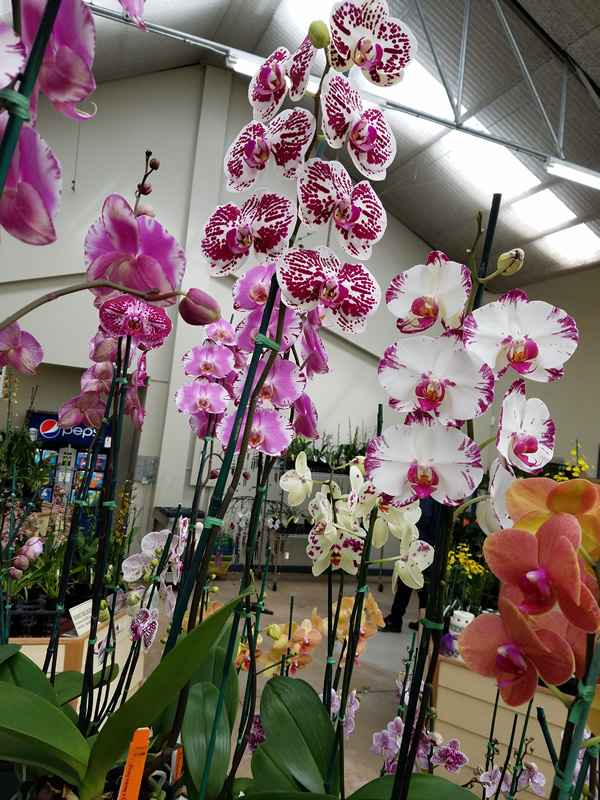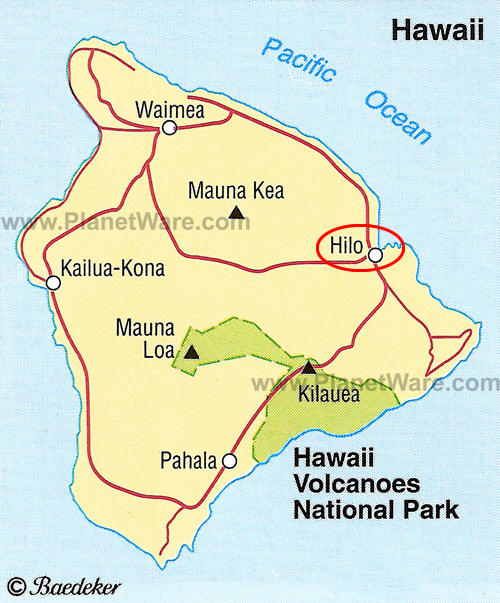Hilo Hawaii January 25
After five days at sea this morning land looked pretty good despite being greeted with rain and clouds. When we left the ship some of us had difficulty walking, expecting the gound to come up to meet us like on shipboard. Crazy as it sounds I even got a little “landsick.” I felt queasy, can’t explain it, but it soon cleared up. Funny thing is that I don’t get seasick.
Unless you are vacationing at Kona (on the sunny side of the island) the main attraction on the big island of Hawaii is the Volcanoes National Park, especially the active volcano Kilauea. "Active" is an understatement. There are parts of the lava bed that are active and parts that look like a dried up gray lake bed. There are many hiking trails, some through rain forest (at 4,000 feet with much rain this is not surprising.) Some of them go through landscape that is desolate and not what I would call attractive.
We lucked out on weather, the day before we to Hilo they had 7 inches of rain. As we climbed the 4,000 feet the clouds slowly broke through and the sky turned blue. During the day we had a few quick, light showers, but nothing that got us very wet.
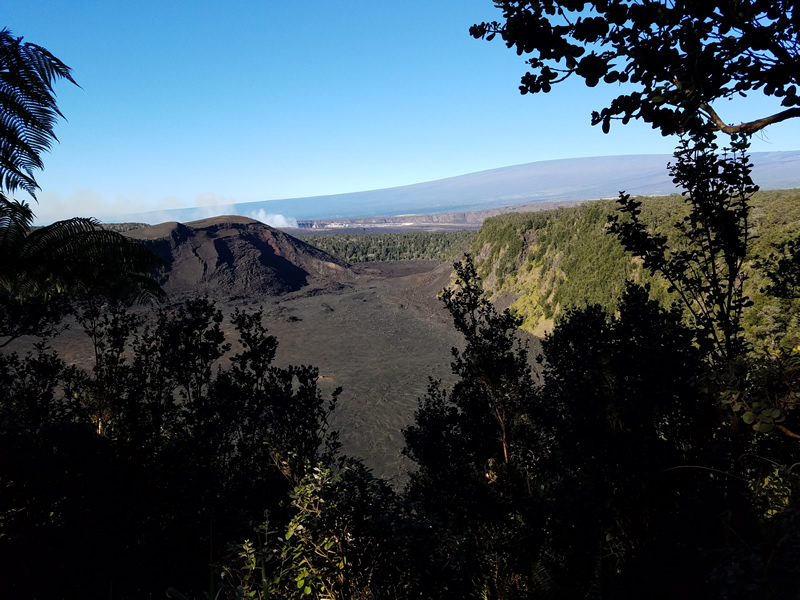
Above is a calera that has parts that are smoking.
During some of its more active periods, Kilauea lava creates some interesting features. The outside of some flows cool quickly and harden while inside the red hot lava is flowing. When that particular flow ceases it leaves a lava tunnel. Thurston Lava Tunnel is a perfect example and we enjoyed a hike through it. Because of the rain the day before there were puddles inside the tunnel because It is not “water proof.” I hope that you can get an idea of the length from the picture below.
When lava flows more quickly in a manner akin to a flooding stream it causes mass destruction. One example of this is Destruction Trail where we had a short hike. This area was subjected to a 37 day eruption in December and November 1959. Sometimes trees leave a hole in the lava, other times there is charcoal where the tree was. When a volcano is erupting violently there are times when it will leave a tree and throw rocks into a tree which for some reason survives. Once the flow stops, the ground "quickly" (in geological terms) becomes fertile and we witnessed some of the earliest plants. Below is one of the earliest trees, 50+ years later...
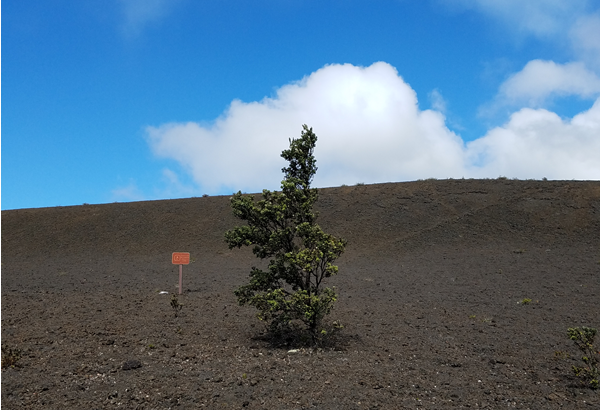
We drove down Chain of Craters Road, so named for all the lava formations left by the volcano. Now that road stops 9 miles from the ocean, but in 2003 when Dex and I visited the park we were able to drive all the way to the ocean where we witnessed the steam that results when red hot lava meets the ocean. That day we saw places where the lava was red hot. The Craters road had been closed the week before we arrived so we were lucky to be able to drive down it. The next day as we were driving around the crater (I honestly think that we could drive all the way around it then, but am not sure – but you cannot now.) someone told us that we should go back down the Crater road because there had been a big lava flow during the night. They were right! We could not get down to where we had stood the day before because it was covered with lava. Where we stopped we were a little more than ¼ of a mile away from the lava and I still remember the heat that we felt at that distance. Given that the lava was about 5,000 degrees Fahrenheit I guess that is not too surprising. Suffice it to say that it was uncomfortable enough that we quickly “got out of Dodge!”
On this trip we enjoyed lunch at the Volcano House, the only restaurant in the park. The 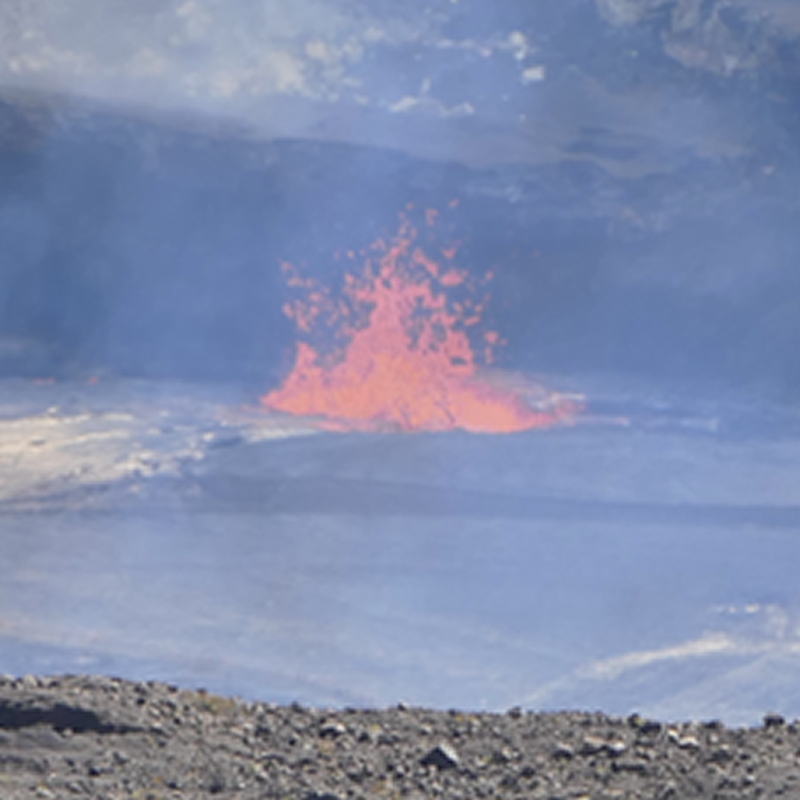 good side is that it has a fabulously great view of part of Kilauea Crater. However, the highlight of the day occurred at Jaggar Museum. We were dutifully watching as the lava bed provided “smoke,” in reality escaping hydrogen sulfide, when we saw a flame dance up and then disappear. It soon reappeared and eventually spread and became constant. We were a mile away and it looked like a fire in a fireplace. We were told that it was leaping up 10 feet and was about 40 feet long. It was hard to stop watching. The lava that flows from this part of the crater enters a lava tube and eventually makes its way 15 miles to the ocean. The land does not build up quickly there because the ocean is so deep and it sinks to the bottom.
good side is that it has a fabulously great view of part of Kilauea Crater. However, the highlight of the day occurred at Jaggar Museum. We were dutifully watching as the lava bed provided “smoke,” in reality escaping hydrogen sulfide, when we saw a flame dance up and then disappear. It soon reappeared and eventually spread and became constant. We were a mile away and it looked like a fire in a fireplace. We were told that it was leaping up 10 feet and was about 40 feet long. It was hard to stop watching. The lava that flows from this part of the crater enters a lava tube and eventually makes its way 15 miles to the ocean. The land does not build up quickly there because the ocean is so deep and it sinks to the bottom.
On the way back to the ship we stopped at an Orchid Farm. Some of the orchids had a fragrance! We were given an orchid to wear in our hair along with a bobby pin to fasten it. There were many beautiful orchids, one hat I did not buy cost $20,000, although most were reasonably priced.
A few examples of the orchids.
